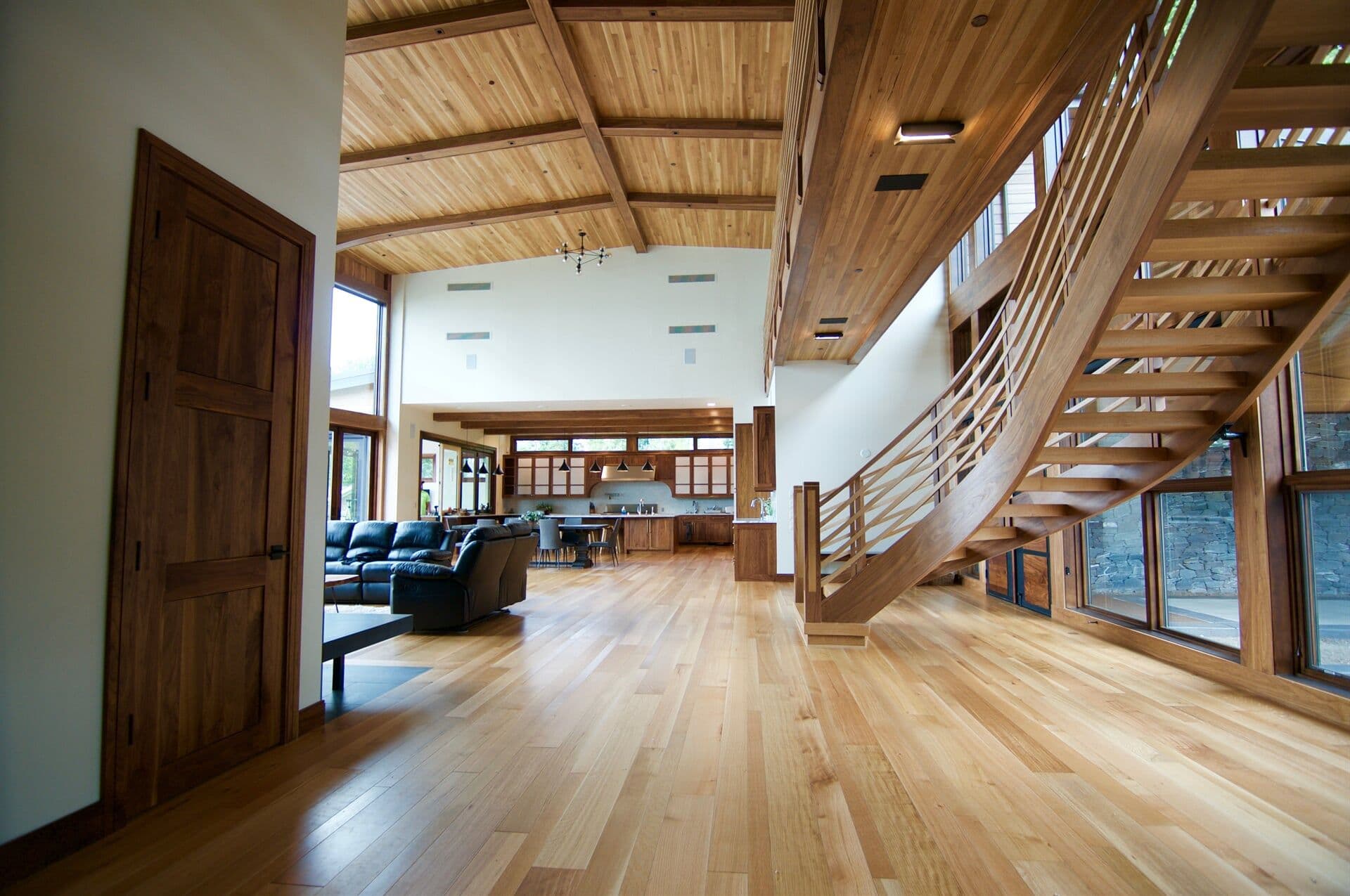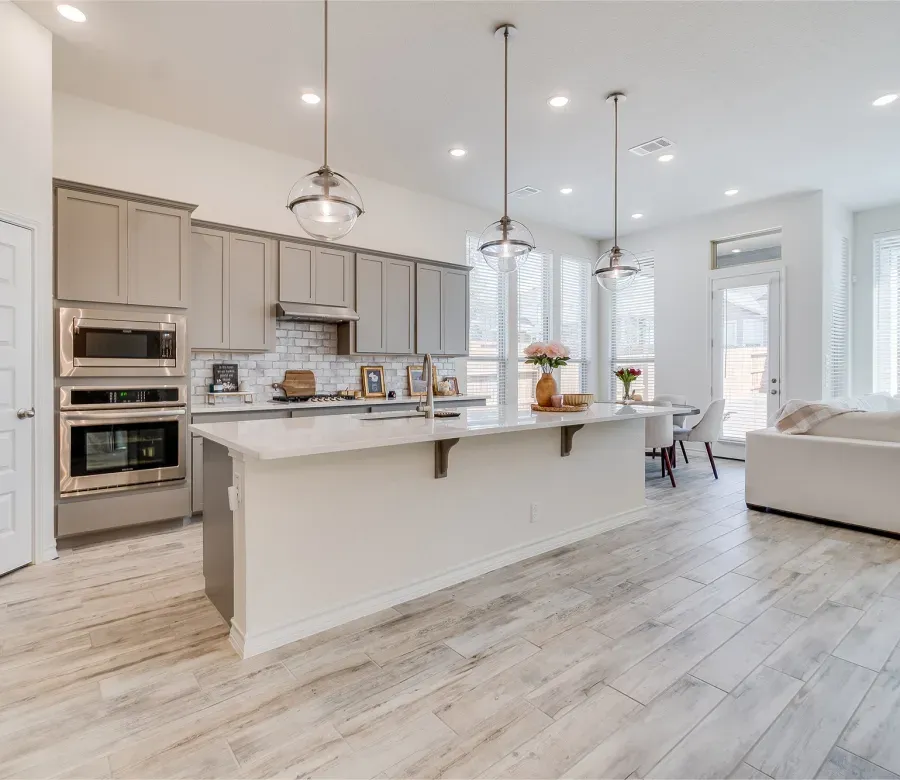
Hardwood Floor Installation
Floors are one of the first things you notice when you go into someone’s home for the first time and hardwood floors, in particular, are an eye-catching option. When you want to give your home a whole new look, scheduling a hardwood floor installation with Ridgeline Floors is one of the best things you can do. Replacing your floors can feel like quite an undertaking, so our goal is to make the process as easy as possible for you. That starts with education. Below, you’ll find an in-depth guide to hardwood flooring and what to expect during the installation process. If you have any questions as you plan for your project, we encourage you to reach out to our experts by calling (770) 299-8433 or contacting us online.
Different Types of Hardwood Floors
When you decide to install hardwood floors in your home, there are a few important decisions you’ll need to make about the types of floors you want. Let’s take a closer look at the three most critical factors to consider when making your decision.
Request An Estimate
Meet with one of our skilled project specialists to get started.
Wood Species
- Acacia: This wood is known for its durability and unique wood grain. It tends to be harder than oak, making it a great option for high traffic areas.
- Brazilian cherry: This popular wood has a reddish-brown color and a slightly coarse grain. It tends to be a bit more stable compared to red oak.
- Hickory: This wood comes in a range of colors from red, to beige, to brown. This is a popular choice known for its distinct grain pattern and strength.
- Red oak: This wood choice is popular among many for its affordability and durability. It tends to have a subtle pink undertone compared to the brown or yellow undertones seen in oak floors.
- White oak: Many people choose white oak wood because of its long lasting durability and versatility. It is known for its consistent grain pattern and is also popular because of the vast possibilities for stain and finish options.
Finished vs Unfinished
Another important thing to consider when planning your hardwood floor installation is whether you want the material to be finished or unfinished. If you want to have a custom stain applied before the final finish or you want to match the color of existing flooring, then unfinished flooring is your best bet. If you’d prefer a fast installation process, prefinished floors are probably a better choice for your home. These come pre-sanded and sealed, so they can be put in your home quickly.
Solid vs Engineered
You’ll also need to decide whether you want solid hardwood floors or engineered hardwood floors in your home. As the name suggests, solid hardwoods are made from all wood and they can be refinished and sanded many times. Engineered hardwoods, on the other hand, have a veneer of real wood that’s glued to layered wood underneath, such as plywood. Our flooring experts here at Ridgeline Floors are here to talk to you about your project. We can help you make the right decisions for your needs when it comes to wood species, finish, and solid or engineered wood so you get the floors of your dreams.


What to Consider When Choosing Hardwood Floors
After you decide on those three factors, there are a few other options to think about when picking out the perfect hardwood floors for your home, which we cover below.
Color
Should you install light hardwood floors or would a darker color better suit your home? Choosing the right color for your floors is key to creating a cohesive design throughout your home. Keep in mind that dark floors can create warmth in your home while light floors reflect light and can make the space look bigger.
Direction
You’ll also need to decide which direction you want your floors to lay. As a good rule of thumb, we recommend having your hardwood floors installed lengthwise towards the window, but ultimately, it’s up to you.
Grain pattern
The way a piece of wood is cut makes a different type of grain pattern on the planks. Plain-sawn wood is the most common type of wood grain and has a pattern known as cathedrals. Rift-sawn wood, on the other hand, does not have cathedrals, but it has long and consistent grain, while quarter-sawn wood has a more irregular grain pattern.
Where you plan to install it
Give some consideration to where you plan to install your new flooring. How much foot traffic will the area get? The answer can help you determine which type of hardwood flooring you need.
How much natural light the space gets
Along those same lines, think about how much natural light you get in the areas where you want to install new floors. If you get a lot of natural light, combining that with light floors can make the whole space feel brighter and bigger. If it’s an area without much natural light, you might want to avoid dark floors or the space might feel more cramped than it is
Benefits Of Hardwood
Are you still trying to decide whether hardwood floors are the best choice for your home? Take a look at some of the advantages of choosing this material for your renovation project.
Excellent Durability
If you opt for solid hardwood floors, you can expect them to be very durable and last for years because of the dense structure of the wood they come from. They are a great choice for areas with heavy foot traffic and can easily be refinished to make them look brand new after a couple of years.
Improved Home Value
If you’re thinking about selling your home sometime in the next few years, then you’ll be happy to know adding hardwood floors may increase your home’s value and appeal to more prospective buyers.
Beautiful Appearance
There’s no denying that hardwood floors are beautiful and they instantly give any space an elevated, high-end feel. They can also add an element of warmth to your home, making the space look inviting and cozy.
Low Maintenance
Compared to some other materials, hardwood floors require very little maintenance to keep them looking great. As long as you keep up with regular cleaning, you can expect your hardwood floors to look good as new for the foreseeable future.
What to Expect During Hardwood Floor Installation
When you hire Ridgeline Floors for your hardwood floor installation, we will work quickly and efficiently to transform your home with as little disruption to your life.
Here’s what you can expect during the installation process.
- Preparation: First things first, we’ll prepare the area where we’ll be installing your new floors. This includes removing furniture and other items from the room, wall hangings, baseboards, etc. Once everything is out of the way, we can start preparing the subfloor.
- Board racking: Next up, we’ll lay out the wood planks to determine where they will go before we begin the installation. This helps to give your floors a more finished, cohesive look, as it ensures that the color of your floors flows smoothly.
- Installation: After the racking process, we’ll start the actual installation, nailing down the boards to the subfloor and working our way throughout the room.
- Finishing: If you decide to install finished hardwood floors, then our work is complete. If you choose unfinished hardwood floors, we’ll then sand, stain, and finish the planks before cleaning up after ourselves and doing a final inspection.

Why Choose Ridgeline Floors?
Over the years, our company has built a reputation as being known for our craftsmanship. We take pride in the work that we do and we’re always focused on customer satisfaction as our top priority. To ensure you have the best possible experience, we use dust containment processes and do everything in our power to maintain a clean and safe worksite.
Reimagine Your Space
Contact Ridgeline Floors

Mon-Sun By Appointment Only
